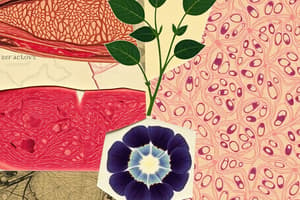Podcast
Questions and Answers
Which of the following organelles are found in plant cells but not in animal cells? (Select all that apply)
Which of the following organelles are found in plant cells but not in animal cells? (Select all that apply)
- Chloroplast (correct)
- Mitochondria
- Vacuole (correct)
- Cell Wall (correct)
What are the two structural systems of plants?
What are the two structural systems of plants?
Shoot system and root system
The outer protecting tissue in plants is known as ______.
The outer protecting tissue in plants is known as ______.
dermal
What is the function of chloroplasts?
What is the function of chloroplasts?
Animal cells have a cell wall.
Animal cells have a cell wall.
Match the following plant tissues with their descriptions:
Match the following plant tissues with their descriptions:
What are the two main structural systems of plants?
What are the two main structural systems of plants?
Which of the following organelles is responsible for photosynthesis in plant cells?
Which of the following organelles is responsible for photosynthesis in plant cells?
Animal cells contain a cell wall.
Animal cells contain a cell wall.
The organelle responsible for storing metabolites and maintaining turgor pressure in plant cells is the ______.
The organelle responsible for storing metabolites and maintaining turgor pressure in plant cells is the ______.
Match the following types of plant tissues with their characteristics:
Match the following types of plant tissues with their characteristics:
Flashcards are hidden until you start studying
Study Notes
Overview of Organ Systems
- Complex organisms are organized into organ systems.
- Each organ system consists of multiple organs.
- Organs are made up of different tissues.
- Tissues contain specialized cells with specific functions.
Importance of Plants
- Plants are vital for life, as they provide food and oxygen.
- They play a crucial role in regulating the water and carbon cycles in the biosphere.
Characteristics of Plant Cells
- Composed of multicellular structures with a defined nucleus.
- Contain specialized organelles for distinct functions.
- Unique organelles in plant cells include:
- Cell Wall: Provides shape, support, and protection.
- Chloroplasts: Responsible for photosynthesis.
- Vacuole: Large fluid-filled sac that stores metabolites and maintains turgor pressure.
Plant Structural Systems
- Plants consist of two main structural systems:
- Shoot System: Above-ground parts like leaves, stems, fruits, and flowers.
- Root System: Below-ground components, including roots and tubers.
Classification of Plant Tissues
- Plant tissues are categorized based on structure and function:
- Dermal Tissue: Protective outer layer, includes epidermis (outermost layer).
- Ground Tissue: Inner plant tissue, comprises:
- Parenchyma: Involved in storage, photosynthesis, and tissue repair.
- Sclerenchyma: Provides structural support and strength.
- Collenchyma: Offers flexible support to growing parts of the plant.
- Vascular Tissue: Responsible for transport of water, nutrients, and sugars throughout the plant.
Overview of Organ Systems
- Complex organisms are organized into organ systems.
- Each organ system consists of multiple organs.
- Organs are made up of different tissues.
- Tissues contain specialized cells with specific functions.
Importance of Plants
- Plants are vital for life, as they provide food and oxygen.
- They play a crucial role in regulating the water and carbon cycles in the biosphere.
Characteristics of Plant Cells
- Composed of multicellular structures with a defined nucleus.
- Contain specialized organelles for distinct functions.
- Unique organelles in plant cells include:
- Cell Wall: Provides shape, support, and protection.
- Chloroplasts: Responsible for photosynthesis.
- Vacuole: Large fluid-filled sac that stores metabolites and maintains turgor pressure.
Plant Structural Systems
- Plants consist of two main structural systems:
- Shoot System: Above-ground parts like leaves, stems, fruits, and flowers.
- Root System: Below-ground components, including roots and tubers.
Classification of Plant Tissues
- Plant tissues are categorized based on structure and function:
- Dermal Tissue: Protective outer layer, includes epidermis (outermost layer).
- Ground Tissue: Inner plant tissue, comprises:
- Parenchyma: Involved in storage, photosynthesis, and tissue repair.
- Sclerenchyma: Provides structural support and strength.
- Collenchyma: Offers flexible support to growing parts of the plant.
- Vascular Tissue: Responsible for transport of water, nutrients, and sugars throughout the plant.
Studying That Suits You
Use AI to generate personalized quizzes and flashcards to suit your learning preferences.




